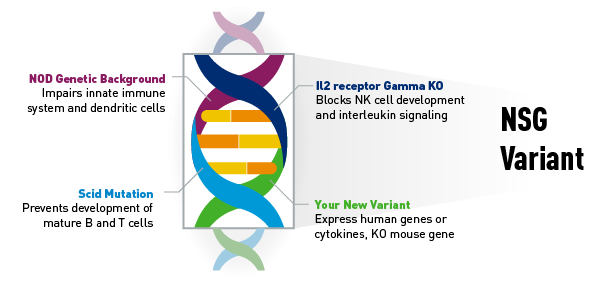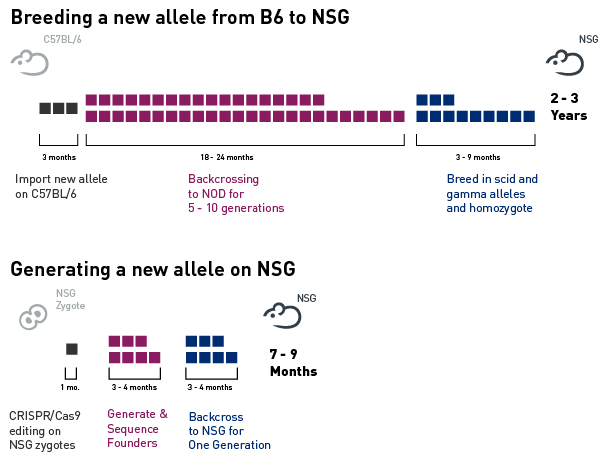How To Make Your New NSG Variant in a Fraction of the Time

CRISPR/Cas9 can quickly generate new translational mouse models directly on the genetic background needed for your preclinical research. This saves valuable research time by reducing the need for years of backcrossing while simultaneously preserving the genetic quality of your mouse models. The power and efficiency of this technology is particularly evident when generating complex multi-allelic strains on unique genetic backgrounds. Here, we highlight the utility of CRISPR/Cas9 in generating new NSG variants to support your preclinical immuno-oncology research.
The NSGTM Mouse Platform
The NSGTM mouse platform is the most useful and versatile immunodeficient mouse model to date. It is an effective platform for immuno-oncology, in part due to its ability to engraft human and mouse tumor cells and cancer cell lines without rejection, as well as model the human immune system by acting as an effective host for human immune cells.
In recent years, new variants of the NSG mouse have further leveraged the potential of the model for various immuno-oncology applications. For example, NSG with the addition of a transgene expressing human IL-15 [NSG-Tg(Hu-IL15)] enables the improved engraftment and expression of human NK cells, while the deletion of the MHC class I and class II loci [NSG-MHC I/II DKO] delays the GvHD response from engraftment of human PBMCs to promote long-term studies. Indeed, there are now a wide range of NSG variants available to help you achieve your research goals.

NSG stands for "NOD scid gamma". To generate the NSG mice, the Prkdcscid "scid" mutation and the Il2rg "gamma" knockout were bred to the immunocompromised genetic background NOD/ShiLtJ. NSG variants retain the base genetic components of NSG, with additional alleles to impart new functions.
Creating New NSG Variants to Support Your Immune-Oncology Research Program
While many new NSG variants are becoming commercially available, some researchers may find themselves in need of a specific variant that does not yet exist or is not available to them. There are many reasons for making a new NSG variant to support your research, including:
- Investigate the mechanism of a gene (mouse or human) on disease progression
- Insert a human gene target for testing new therapies
- Generate a more effective platform for engrafting specific human cells
- Create an immune microenvironment that is more clinically relevant to humans
Making a new NSG variant may seem daunting at first, however there are several strategies that can be used and resources to support this endeavor.
Efficient Strategies for Generating New Alleles on NSG
There are two primary strategies to generate a new allele on NSG. First, let's say you find an existing mouse strain that has your new allele of interest, however it is on a C57BL/6J genetic background. In order to get this allele on NSG, you would need to first backcross to the NOD genetic background for 5-10 generations, then breed in the scid and Il2 receptor gamma alleles. This process will take an average of 2 - 3 years to generate your new NSG variant.
A more sophisticated approach would be to use CRISPR/Cas9 to generate the new allele directly in NSG. NSG embryos are highly amenable to genetic modifications, so gene editing can be done directly in the zygote developmental stage. This CRISPR project would involve procuring or synthesizing all reagents, which are then used to genetically modify the NSG zygotes. The resulting pups would be sequenced to identify the founders, then backcrossed to NSG for a single generation to propagate the line. Start to finish, with CRISPR/Cas9 a new NSG variant carrying your allele can be made in 7-9 months!

Getting Started on Your New NSG Variant
JAX can make new knockouts, genetic humanizations, reporters, and more in the NSG mouse. We have generated more than 100 new models in the NSG mouse to date! You don't need to be a genetics expert to embark on such a project — JAX has scientists who will consult with you on your research goals and help design your new NSG variant. JAX offers a no-risk guarantee for most projects, so if we are not able to produce the mice as specified, there will be no charge to you. JAX Model Generation Services has many other tools for generating new mouse models, including DNA and ES cell microinjection and new technologies for larger DNA insertions. Making your new NSG variant is just the start — JAX can also breed to generate cohorts of your new strain and assist with all your preclinical in vivo testing projects so that you can have a one-stop-shop for all of your mouse needs. Learn more about what it's like to work with JAX on a custom model generation project.
Contact JAX today to get started on your NSG variant!